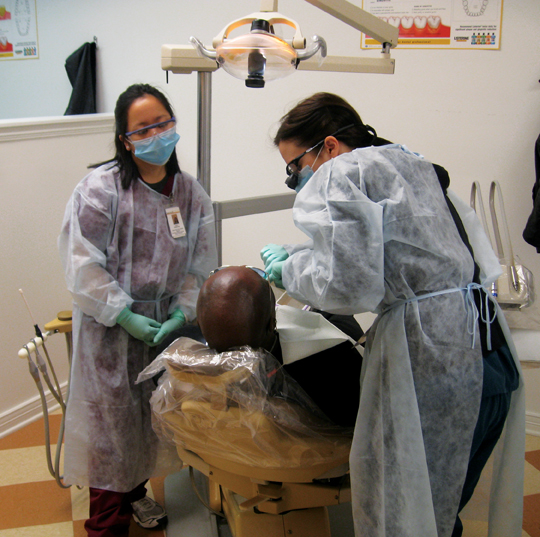Goldie's Place

Goldie's Place student-run dental clinic offers eye-opening experience
Chicago is home to the nation’s first skyscraper (built in 1884), and is the birthplace of both the car radio and the TV remote control. But it has something else we should be proud to show off. Established three years ago, the dental clinic at Goldie’s Place is home to the nation’s first student-run dental clinic.Goldie’s Place, which started in 1996, is a support center for homeless people working to get back on their feet. It offers career training, resume building, a clothes closet and a dental clinic. During the week, a staff of volunteer dentists runs the agency’s dental clinic. But every other weekend the clinic is transformed into a student-run dental clinic.
Brian Homann, a third year dental student at the University of Illinois at Chicago (UIC) College of Dentistry, was there two years ago for the first four pilot sessions at the student-run dental clinic. He worked the front desk that first day, and experienced something that isn’t taught in dental school.
Mr. Homann says the clinic is unique in that everyone learns how to run a practice by learning how to book appointments and run the front desk – the business side of things.
Caswell Evans, a 1970 graduate of the Columbia University College of Dental Medicine and now the Associate Dean of Prevention and Public Health Services at the UIC College of Dentistry, said, “They [the students] are responsible for gathering supplies, scheduling appointments, working up treatment plans, the reception area, sterilization and taking radiographs.
“The students get first-hand experience with access to care, health disparities and a community that is unrecognized.”
The UIC student chapter of the American Association of Public Health Dentistry organizes the students in the clinic. The UIC chapter was the first student chapter of the AAPHD; Mr. Homann is the current president.
The executive board recruited student volunteers through e-mail, friends telling friends, and by word of mouth.
“We told them how we got these great experiences [at Goldie’s Place] and flocks of people came,” Mr. Homann said.
Once at the clinic, student volunteers are organized by their progress through dental school. First years work the front desk and do sterilization and radiology.
Second years assist the providers and do cleanings, and the third and fourth years are assistants and providers. There is one faculty member present at all times.
“You get to do all these things you don’t get to do at school,” said Mr. Homann. “Because we are working at a community clinic we don’t have all the supplies like we do at school. Goldie’s teaches you how to think on your feet and modify what you’re doing when you don’t have the supply you need.”
Not only do students need to think on their feet, they also are learning about community medicine and working with a patient base that is homeless. Their ideas on what being homeless means are changing.
Mr. Homann took the health history of one patient and found out that he had a PhD and had worked as a college professor, but because his son had been sick and had racked up hundreds of thousands of dollars in bills, the patient had become homeless.
“That really hit it home with me. We see a lot of similar stories at Goldie’s – that someone has just come into some horrible circumstance,” said Mr. Homann.
Because these patients have encountered these experiences in their lives, they are incredibly grateful for the dental work because they have no other options.
Another patient had been homeless for 10 years and without any teeth. The students had a set of dentures made for him by dental labs that donate their services.
“He had a huge smile on his face. He gave everyone in the clinic high fives and hugs and then danced his way out of the clinic. He was going to go eat solid food for the first time in 10 years,” said Mr. Homann.
For the students, Goldie’s Place has been great for giving them real world experience; and for the patients who have received the treatment, they are able to go back out into the world with a new smile.
Ms. Azark is the editorial assistant for the Chicago Dental Society.
